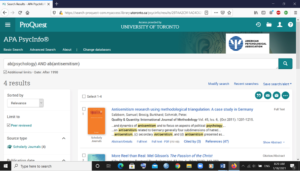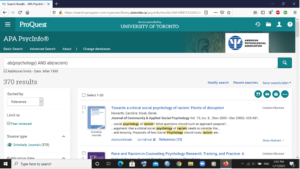As a newly appointed ISGAP Senior Research Fellow and a psychologist, I was excited to begin exploring and adding to psychological insights in the study of antisemitism that earlier colleagues had discovered, with a particular emphasis on the last three decades. I did a search that I thought would uncover advances in the field beyond:
- The well-known, empirical post-Holocaust literature (e.g., Milgram’s Obedience to Authority study; Milgram, 1963),
- Individuals’ tendencies to assume punitive or victim roles when assigned by authority figures (e.g., Zimbardo’s Stanford Prison study; Haney, Banks & Zimbardo, 1973),
- The behavioural inaction to a victim’s suffering when sufficient numbers of others witness an ongoing crime (g., bystander inaction during the brutal murder of Kitty Genovese; Latane ́& Darley, 1968), or
- Authoritarian characteristics of individuals most susceptible to obeying authorities and suspending their moral principles (Adorno, Frenkel-Brunswik, Levinson & Sanford, 1950).
Beyond this article’s scope there is the considerable disagreement in the more recent literature regarding the limitations of inferences, or even the veracity, of these iconic studies between their critics and supporters. One non-academic but interesting observation was posted by an otherwise anonymous “Mikhail” on a “factmyth.com” website (July 19, 2019) who observed,
“Why is authority always viewed negatively? Almost every idea of truth or moral right relies in one way or another on authority for most people. When an authority is disobeyed, it’s usually because its legitimacy is called into question by reference to some other authority. The problem with nazis (sic) wasn’t that they used their authority, it was that they managed to control the formation of common sense and consensus opinion in Germany through censorship, propaganda and violence against their opponents. Authority and obedience to it in itself is a good thing.” (Emphasis added.)
Retrieved from http://factmyth.com/factoids/on-average-people-naturally-obey-authority/ January 17, 2021.
I decided to conduct a broad search for peer-reviewed articles in the psychology literature between 1990 and the present, expecting to find a broad and deep array of empirical studies shedding specific insight into the psychological mechanisms, and specific nuances intrinsic to antisemitism. My search terms were “psychology” and “antisemitism” appearing in the Abstract. I was shocked to find only four publications in peer-reviewed journals.[1], [2] Of the four, only a single paper was an original empirical study. Fortunately, in my opinion, this study is a methodologically sophisticated and psychodynamic-grounded investigation set in Germany. The authors (Salzborn, Grossig & Schmidt, 2011) distinguish between four sources of antisemitism in Germany:
- Christian religion-based antisemitism,
- Biologically-based racist antisemitism,
- Secondary antisemitism, reflecting an attempt to alleviate, minimize or deflect German guilt and shame for the Holocaust, and
- Antisemitism manifested as antizionism.
Methodologically, they utilized a “triangulation model,” which was reflected in their underlying theory of attitudes: justifying their large (n = 2,000) and objective psychometric survey; connected sampling for subsequent interviews; and their psychodynamic theory and derivative technique for interpreting (“deconstructing”) the results of their telephone interviews. The content of the questions were either related openly to antisemitic sentiments that have become more acceptable to express (e.g., “Jews have too much influence in Germany,” and “The Jews are responsible for their persecution on account of their behavior”), or related explicitly to secondary antisemitism (“Many Jews today try to turn the history of the Third Reich to their advantage,” and, “I am angry that the crimes committed against the Jews are still being held against the Germans today.”). A high degree of agreement was found to the first two questions. In contrast, a moderate degree of agreement was found for the second type of question. Additionally, by comparing responses to the two types of questions, researchers were able to pinpoint the relative salience of general versus secondary antisemitism in individual respondents. This information could be used effectively to speak to an individual’s particular motivation to embrace and express antisemitic tropes.
The first of the other three articles identified in the search was a 1998 paper by Winston. The paper describes the antisemitic academic practices of prominent psychologist, E.G. Boring, in identifying students’ Jewishness, and associated negative traits in letters of recommendation that he wrote for them.
The second, by Kille (2005), analyzed the antisemitism in Mel Gibson’s movie, The Passion of the Christ, from a religious perspective. The third paper, by Salgado (2011), presents an analysis of Otto Weininger’s philosophy, contending that Weininger was primarily an ethicist.
“I will reveal that his characterological psychology is subjected to the indisputable sovereignty he bestows on ethics.” (From Salgado’s Abstract)
Weininger, was born Jewish but believed that “Jewishness” was a negative trait in all of humanity. He later converted to Christianity and committed suicide at the age of 23. Still, his lone book, “Geshlecht und Charackter” (Sex and Character), was misogynistic and antisemitic, and served as a cornerstone for the Nazi movement (Weininger, Wiki, undated, retrieved January 17, 2021). Aside from confirming, yet again, that people born Jewish can harbour deep antisemitic sentiments, there is little psychological value or insights in this paper.
For comparison, I carried out a parallel search for psychology and racism, finding that 370 peer review papers were identified during the same three decades.[3] It is understandable that racism enjoys broader appeal than antisemitism for both researchers and granting agencies. The ratio of 92.4 to 1, though, seems a bit disproportionate.
The implications of this limited study are clear: far too little empirical psychological research has been conducted on antisemitism during the last three decades. Consequently, the previous empirical research projects alluded to above need significant updating. Certainly, the contemporary psychology of antisemitism can cautiously borrow from what has been learned about racist individuals and racist movements, but always keep in mind that while they likely share common elements, there are important distinctions as well. A theoretically based structure is necessary so that future efforts do not lump all antisemites together and search for non-existent commonalities between divergent groups who may only share a superficial similarity endpoint in their distaste or hatred for Jews.
In my career, I examined a number of disparate areas that I believe can be germane to understanding antisemitism at political, ideological, organizational, and individual levels.
These areas include:
- Understanding different types of aggression and their motivational triggers (Nussbaum, Saint-Cyr & Bell, 1997; Levi, Nussbaum & Rich, 2010; Bass & Nussbaum, 2010),
- Individually based risk assessment (Nussbaum, 2006; Nussbaum, 2020),
- The neural bases of decision-making (Nussbaum, Honormand, Govoni, Kalahani-Bargis, Bass, Ni et al., 2011), and
- Extremism/terrorism (Nussbaum, 2016).
My immediate goal as a new Senior Research Fellow at ISGAP is to help establish a sufficiently broad and deep psychological framework to accommodate the complexities of organisational, group, and individual differences leading to and sustaining antisemitism. The ultimate goal is to provide insights to effectively counter the distinct yet recurring patterns of biased perceptions, restricted and distorted cognitions, unregulated emotions that interfere with sound reasoning, and unbalanced motivations that combine in different individuals to induce and sustain Jew-hatred. I have no illusions that this necessary goal will be accomplished easily, quickly, or without extensive collaboration. However, it appears long past due for psychologists and psychology departments, and private and public granting agencies, to begin funding empirical psychological research on the various causes and sustaining forces of this oldest and unremitting hatred.
**********
References:
Adorno, T.W., Frenkel-Brunswik, E., Levinson, D.J., & Sanford, R.N. The Authoritarian Personality. New York: Harper, 1950.
Bass, S.L.S. & Nussbaum, (2010.) Decision making and aggression in forensic psychiatric inpatients. Criminal Justice and Behavior, 37, 365-383.
Haney, C., Banks, W., & Zimbardo, P. (1973). Interpersonal dynamics in a simulated prison. International Journal of Criminology and Penology, 1, 69-97.
Kille, D. A. (2005). More reel than real: Mel Gibson’s 0RW1S34RfeSDcfkexd09rT2the passion of the christ1RW1S34RfeSDcfkexd09rT2. Pastoral Psychology, 53(4), 341-350. doi:http://dx.doi.org.myaccess.library.utoronto.ca/10.1007/s11089-005-1365-z
Latane ́, B., & Darley, J. M. (1968). Group inhibition of bystander intervention in emergencies. Journal of Personality and Social Psychology, 10, 215–221.
Levi, M., Nussbaum, D. & Rich, J. B. (2010.) Neuropsychological and personality support for application of Moyer’s aggression typology to offenders. Criminal Justice and Behavior, DOI: 10.1177/0093854810362342.
Milgram, S. (1963). Behavioral Study of obedience. The Journal of Abnormal and Social Psychology, 67(4), 371–378. https://doi.org/10.1037/h0040525
Nussbaum, D. (2006) Recommending Probation and Parole. (Ch. 16) In: I. Weiner & A. Hess. (Eds.) The Handbook of Forensic Psychology, Third Ed. Pgs. 426-486. Hoboken, N.J.: John Wiley & Sons.
Nussbaum, D. (2016.) The Extremist Mind, Guiding Ideologies, Organizational Hierarchies and Behavioural Outcomes: An Integrative Psychological Perspective. Keynote Address. Psychological Society of Kenya Annual Congress, Mombasa, Kenya, November 17th.
Nussbaum, D. (2020.) Aggression from a Psychobiological Perspective: Implications for Enhanced Violent Risk Assessment and Interventions. Ch. 16 in: Handbook of What Works in Violence Risk Management: Theory, Research and Practice, First Edition. Edited by Stephen J. Wormith, Leam A. Craig and Todd Hogue. John Wiley & Sons Ltd.
Nussbaum, D., Honormand, K., Govoni, R., Kalahani-Bargis, M., Bass, S., Ni,. X. LaForge, K., Burden, A., Romero, K., Basarke, S., Courbasson, C. & Deamond, W. (2011.) An Eight Component Decision-Making Model for Problem Gambling: A Systems Approach to Stimulate Integrative Research. J. Gambling Studies, 27, 523-563.
Nussbaum, D., Saint Cyr, J. & Bell, E. (1997). A biologically derived, psychometric model for understanding, predicting and treating tendencies toward future violence in humans. American Journal of Forensic Psychiatry. 18, 4, 35-50.
Ariso Salgado, J. M. (2011). La psicología se tiñe de ética: El determinismo caracterológico de otto weininger (1880-1903). Revista De Historia De La Psicología, 32(4), 19-36. Retrieved from http://myaccess.library.utoronto.ca/login?qurl=https%3A%2F%2Fwww.proquest.com%2Fscholarly-journals%2Fla-psicolog%C3%ADa-se-ti%C3%B1e-de-%C3%A9tica-el-determinismo%2Fdocview%2F1267039745%2Fse-2%3Faccountid%3D1477
Salzborn, S., Grossig, B., & Schmidt, P. (2011.) Antisemitism research using methodological triangulation: a case study in Germany. Qual. Quant. 45, 1201–1215.
Weinnger, O. Wiki. https://incels.wiki/w/Otto_Weininger Retrieved January 17, 2021.
Winston, A.S. (1998.) “The defects of his race:” E. G. Boring and Antisemitism in American Psychology, 1923-1953. History of Psychology, 1, 27-51
**********
Appendix: PsycINFO Search Screen Shots
- “antisemitism and psychology” Search Result Screen:
- “racism and psychology” Search Result Screen:
**********
Footnotes
[1] There are a number of books written on antisemitism by psychologists, but these are typically essay-style, based on historical data, written to provide broad perspectives favoured by the authors, rather than furnish original empirical data to evaluate specific hypotheses.
[2] See Appendix 1
[3] See Appendix 2
To submit an article to ISGAP Flashpoint, paste it into the email body (no attachments). Include a headline, byline (author/s name), and a short bio (max. 250 words) at the end. Attach a high-quality headshot. Send submissions to [email protected].



